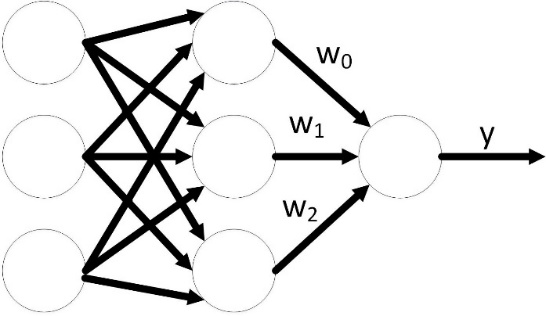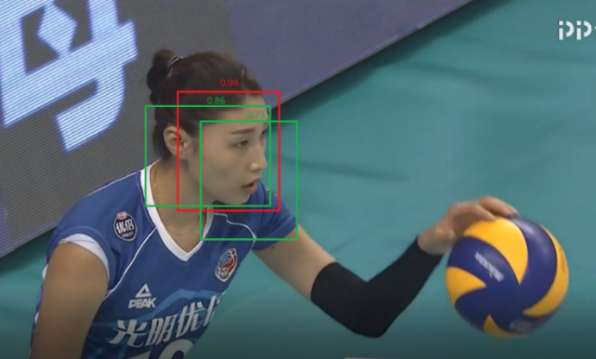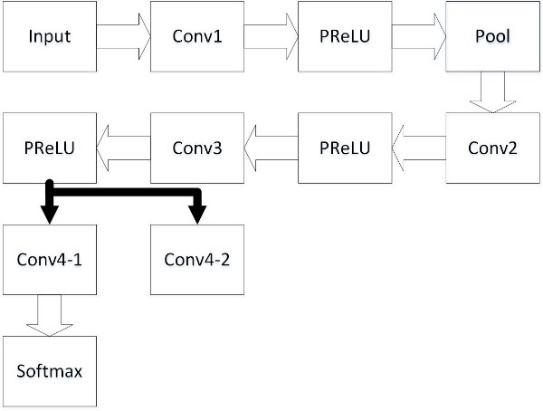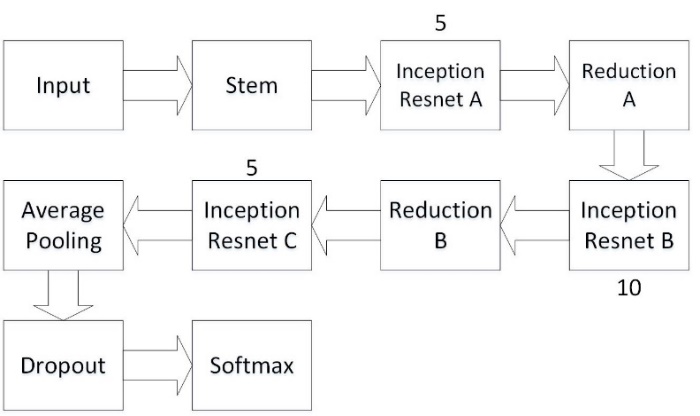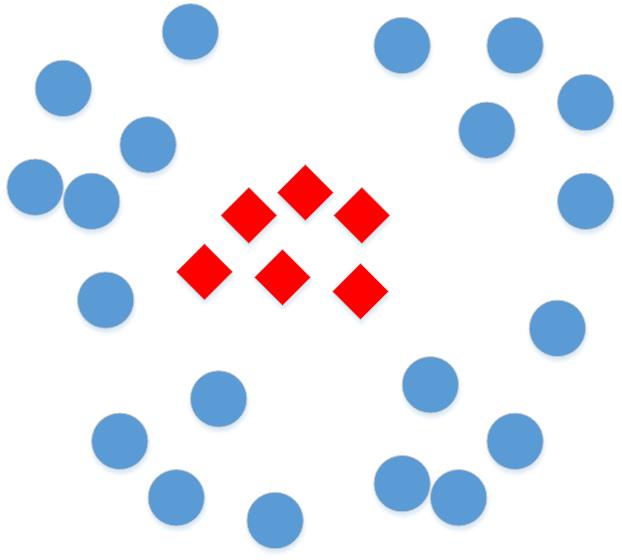基于CNN的排球赛视频中球员人脸识别算法设计与实现毕业论文
2020-02-16 12:11:24
摘 要
自上世纪至今,排球已成为中国人民喜爱的球类运动之一。尽管如此,还有相当一部分群体对排球运动了解不多,这阻碍他们享受观看排球比赛的乐趣。近几年人脸识别技术的快速发展使得排球比赛视频中球员身份的鉴别成为可能,从而可在视频中的相应位置标注该球员的相关信息,帮助观众了解排球运动员。同时,计算机可自动记录球员的比赛数据,供教练分析球员的优缺点以制定训练计划完成前期的准备工作。
本文主要研究基于卷积神经网络的排球赛视频中球员人脸的识别方法,并将球员信息标注在球员人脸附近。主要工作内容如下:
(1)基于MTCNN的视频中球员人脸检测算法设计与实现。本算法中使用三个级联的卷积神经网络来生成和筛选视频中可能存在人脸的区域。第一个网络生成多个人脸候选框,并由第二个网络进行筛选,初步淘汰掉不存在人脸的候选区域。第三个网络进一步淘汰非人脸区域,给出相应的置信度以及人脸候选框、左眼、右眼、左嘴角、右嘴角和鼻尖的位置信息。
(2)基于FaceNet的视频中球员人脸识别算法设计与实现。人脸检测后,本算法使用Inception Resnet V1卷积神经网络提取对应位置的人脸特征,再将其映射为欧氏空间中的特征向量,通过特征向量间的欧式距离来判别该人脸属于哪一位球员。FaceNet中使用三元组损失函数来优化卷积神经网络的参数,提高特征提取的能力。
实验结果表明:排球赛视频中球员的人脸识别能够达到较好的效果,可识别出多数不受遮挡和少数受遮挡的球员,但是物体的遮挡和球员的运动会大大降低识别效果。
关键词:排球比赛;人脸识别;卷积神经网络
Abstract
Since last century, volleyball has been one of Chinese favorite ball games. However, there are still some people in China who donrsquo;t understand volleyball at all. It could prevent them experiencing joy and satisfaction when watching a volleyball match. With the development of face recognition technology in recent years, we can identify the players in the competition video. Thus, it enables us to mark their personal information in the game video which can promote the knowledge of players of the audiences. At the same time, it makes preparation for the work that computer automatically records the competition data of players. Thus, itrsquo;s useful for the coach to develop training program according to the analysis of their strengths and weaknesses.
In this thesis, the face recognition algorithm based on convolutional neural network is researched to apply it to the video, and playersrsquo; information is presented on video where is close to the vicinity of the faces. The main work contents are as follows:
(1)The faces detection algorithm for players in video is designed and implemented based on MTCNN. It uses three cascaded convolutional neural network to generate and filter the area containing faces. Many facial candidate boxes are generated by the first network. Then, boxes without faces are initially eliminated by the second network. The last network not only further eliminates no face areas, but also outputs the corresponding confidence and the coordinate of facial boxes, eyes, mouth and nose.
(2)The faces recognition algorithm for players in video is designed and implemented based on FaceNet. After detecting faces, it uses Inception Resnet V1 convolutional neural network to extract the face feature which is in the candidate box and maps the feature to European space. Through the European distance between two feature vector, it enables to determine which player the face belongs to. In FaceNet, triplet loss is used to optimize the parameters in the convolutional neural network for promoting the ability of extracting feature.
Experiment results imply that playersrsquo; faces recognition on volleyball game video achieves good standards. The majority of players who isnrsquo;t shielded and the minority of the shielded are identified. Nevertheless, the precision reduces due to the shield of obstacles and playersrsquo; moving.
Key Words:volleyball game;face recognition;convolutional neural network
目 录
第一章 绪论 1
1.1 人脸识别背景及意义 1
1.2 人脸识别的研究现状 1
1.3 本文的主要工作 2
1.4 本文结构 3
第二章 排球赛视频中球员的人脸检测 4
2.1 视频中球员人脸检测分析 4
2.2 卷积神经网络基本结构 4
2.2.1 神经网络 4
2.2.2 卷积神经网络 6
2.3 基于MTCNN的球员人脸检测算法设计 9
2.3.1球员人脸检测的步骤 9
2.3.2 MTCNN网络结构 12
2.3.3 损失函数 15
2.4 适用场景 15
2.5 本章小结 16
第三章 排球赛视频中球员的人脸识别 17
3.1 视频中球员人脸识别分析 17
3.2 基于FaceNet的球员人脸识别算法设计 17
3.2.1球员人脸识别的步骤 17
3.2.2 Inception Resnet V1网络结构 18
3.2.3 损失函数 22
3.2.4 Triplet的选择策略 23
3.3 SVM分类器 23
3.4 球员信息的标注与播报 24
3.5 本章小结 26
第四章 实验及结果分析 27
4.1 实验环境和数据集 27
4.1.1 实验环境 27
4.1.2 数据集 27
4.2 评价指标 28
4.3 球员人脸检测的实验结果及分析 28
4.3.1 非极大值抑制算法阈值的选择 28
4.3.2 网络阈值的选择 30
4.3.3 实验结果展示 32
4.4 球员人脸识别的实验结果及分析 35
4.4.1 学习率的选择 35
4.4.2 实验结果展示 36
4.5 本章小结 38
第五章 总结与展望 39
参考文献 hellip;hellip;hellip;hellip;hellip;hellip;hellip;hellip;hellip;hellip;hellip;hellip;hellip;hellip;hellip;hellip;hellip;hellip;hellip;hellip;hellip;hellip;hellip;hellip;hellip;hellip;hellip;hellip;hellip;hellip;hellip;hellip;hellip;..40
致 谢 hellip;hellip;hellip;hellip;hellip;hellip;hellip;hellip;hellip;hellip;hellip;hellip;hellip;hellip;hellip;hellip;hellip;hellip;hellip;hellip;hellip;hellip;hellip;hellip;hellip;hellip;hellip;hellip;hellip;hellip;hellip;hellip;hellip;hellip;..42
第一章 绪论
1.1 人脸识别背景及意义
排球赛视频中球员的身份鉴定可通过人脸识别(Face Recognition)实现,即从获取到的视频流中通过球员的脸部进行身份鉴别。
人脸识别的实现通常需要经过人脸检测、人脸对齐和特征表征这三个阶段。先通过人脸检测定位到图像中人脸的位置,再对所定位到的人脸进行相似变换,把不同角度和表情的人脸转换到同一角度和姿态中,以此提高识别的准确度。最后,从变换后的人脸中提取特征,利用分类器判别以获取结果。
人脸识别技术在监控、支付、身份认证等领域都有着重要的应用价值。警察可以通过监控与人脸识别技术搜索逃犯,提高破案效率;支付终端可以通过人脸识别技术节省结账时间,方便人们出行;火车站可利用人脸识别技术减少旅客的进站时间,避免乘客来不及上车的情况发生。中国女排自上世纪80年代起经过不懈努力已获得9次世界冠军,排球运动已成为中国的一项优势运动,备受国人瞩目。将人脸识别技术应用于排球比赛视频中,可为不熟悉排球队员的观众提供相关信息。同时,计算机还可以基于人脸识别技术自动记录球员的表现情况,例如得分、失误情况等。这节省了教练反复观看比赛视频的时间,为其分析比赛、制定球员训练计划提供依据。
1.2 人脸识别的研究现状
早在20世纪60年代就有研究者提出使用人脸特征来鉴别个体身份,但直到20世纪90年代人脸识别才迎来了第一次大发展,在此期间不少学者提出了沿用至今的方法。Pentland等人[1]在90年代初提出了特征脸方法(EigenFace),其核心思想是将人脸识别问题当作一个二维识别问题来解决。随后许多学者对该方法展开了研究,延伸出不少的变式。1992年麻省理工学院的Poggio等人[2]做了对比试验来研究何种方法的识别性能更加优越,最后他们证明了基于模板匹配的方法能够更好地解决人脸识别问题。通常人脸识别需要从目标对象的多张人脸照片中提取多个特征,基于这样的想法Belhumeur等人[3]提出线性判别分析(Linear Discriminant Analysis)方法。他们设法最大化类间差异,最小化类内差异,使同一个人的多个人脸特征在特征空间中聚集在一起,不同个体的人脸特征相互分开。2014年甘俊英等人[4]基于线性判别方法提出了核零空间线性鉴别分析算法,并成功地应用于人脸识别。
随着机器学习的发展,学者们不断地尝试将机器学习的方法应用到人脸识别中,并取得了巨大的成功。其主要思想是利用多个目标人脸特征来训练、构造分类器,依靠分类器计算出的置信度来判断该图像中是否有人脸、该人脸属于哪一个个体。常使用的分类器有支持向量机和贝叶斯等。2000年,Guo等人[5]提出的基于二叉树策略的支持向量机可应用到人脸识别问题中。Chen等人[6]在2012年发现使用联合贝叶斯的方法来识别人脸比经典贝叶斯方法的准确度更高。随后,他们发现特征维度越高,人脸识别的准确就越高 [7],并受到人们的广泛关注。人脸识别的研究过程中,人们发现物体的遮挡、表情的变化等会降低识别效果,研究者们针对这些问题提出了不少解决方案。其中,2009年Wright等人[8]提出的稀疏表示方法能够解决遮挡等问题。此外,这一时期盛行使用人工设计的特征,LBP[9]为最具代表的特征之一,是一种局部的二值特征。2002年,Ojala等人[10]改进LBP特征,使其对灰度图的旋转、变换等有着良好的鲁棒性。
近年来,神经网络在物体识别领域中展现出卓越的性能,吸引了大量的研究者、工程技术人员。2014年Facebook提出基于深度神经网络的人脸识别方法——DeepFace[11],奠定了深度卷积神经网络在人脸识别领域中的应用。DeepFace使用3D模型完成人脸对齐,通过Softmax来优化问题,在LFW数据集上达到了97.35%的准确度,接近人类水平。
香港中文大学的汤晓鸥团队在2014年提出了DeepID 方法[12],其创新点在于网络模型学习到的人脸特征表征——Deep Hidden Identity Features。Florian等人[13]于2015年推出了FaceNet ,他们使用Triple Loss代替Softmax,其性能优于DeepFace,在LFW上达到了99.63%的准确率。2017年Liu[14]等人基于Softmax提出了A-Softmax损失函数,以提高网络的性能。随后,Deng[15]等人在2018年使用ArcFace增强了Softmax的判别能力,并在MegaFace挑战赛中表现最佳。
以上是毕业论文大纲或资料介绍,该课题完整毕业论文、开题报告、任务书、程序设计、图纸设计等资料请添加微信获取,微信号:bysjorg。
相关图片展示:
